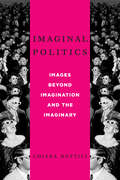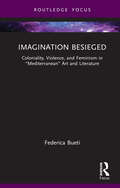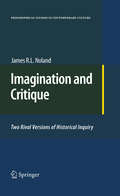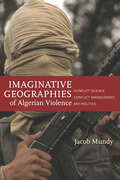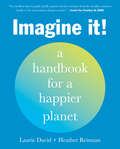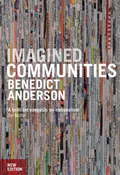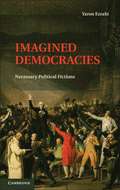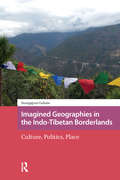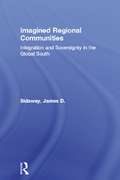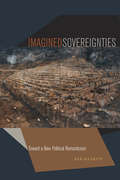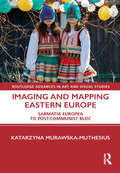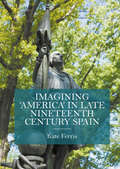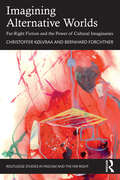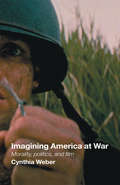- Table View
- List View
Images of Voting/Visions of Democracy
by Peter NatchezWhen survey research, statistics, and electronic data processing were first introduced, they held out promise that a new level of political knowledge would be created. Applied to the study of voting behavior, survey research promised an understanding of the factors determining the outcome of an election, that political history could be based on rich and current data, and that we could begin to understand the role of elections in constitutional democracy. The truth as Peter B. Natchez shows, is that despite the opportunity provided by this revolution, voting studies have failed to make significant contributions to democratic theory or political history.The findings of voting studies have spread from the universities into the political system with a rather grim message. In its simplest form the message is this: the electorate does not measure up to the task thrust upon it by democracy. The studies conclude that voters choose candidates for reasons having little relevance to the success of the political system, and little relevance even to politics. Thus political science, in shifting from an optimistic focus on theory to a strong emphasis on empiricism, became a source of pessimism.One cannot study democracy or the democratic process without a point of view on democracy. The scientific method requires a point of view: science is not only a method for discovering reality, but for addressing well-structured questions. Natchez identifies goals for democracy, freedom and tolerance, and consciousness in decision making. Elections serve two functions; one, filling constitutional offices, and two, a symbolic function rooted in democratic experience that is more ambiguous, but no less vital as a part of regime analysis. A political science that connects these two aspects of voting will require an analysis of why voters vote the way they do to fill offices; but, more importantly, it will also require an understanding of the symbolic function of elections.
Images of the Post-Soviet Kazakshtan: A Cosmopolitan Space with Borderland Anxieties
by Suchandana ChatterjeeThe study revolves round the relationship between space and transitional identity in Kazakhstan in the post-Soviet period. Emergent discourses about cosmopolitanism suggest multiple interactions in a transitional space. The cosmopolitanism of our times implies the dynamic responses of communities in transition. The diversities and heterogeneities instead of the specifics, the encounters, the networks, the challenges, the ways of living, the multitude of fates need to be considered. The picture is far bigger as there are infinite ways of being and belonging. The images are of the many, and as suggested here, relate to the Kazakh conscience. The Kazakh conscience represents a repertoire of diverse opinions regarding Eurasianism, intellectuals’ reformist agenda, zhuz legacy, people’s histories. What stands out is the wider milieu of a cosmopolitan Almaty which is the home of a cultural elite or a citified Astana that has been showcased as the “appropriate site” of the Kazakhs’ steppe identity. The variety is also seen in the case of Uyghur neighbourhoods of Almaty, in the frontiers of Akmolinsk oblast reminiscent of Tsarist Russia’s Cossack military fortresses, in gulag memorials near Astana and in the Caspian hub Atyrau that is iconised as the oil fountain of the present century. Kazakh borderlands have a completely different profile—that of shared spaces. The Kazakhs’ attachment to their homeland is a constant—but the question is whether that territorial reality fits into other paradigms of identity and belonging. Such questions arise in the case of Mongolian Kazakhs and Uyghurs of Semirechie—in both cases the sentiment of place is strong compared to the overwhelming global experiences of the mainland Kazakhs. Please note: Taylor & Francis does not sell or distribute the Hardback in India, Pakistan, Nepal, Bhutan, Bangladesh and Sri Lanka
Imaginal Politics
by Chiara BotticiBetween the radical, creative capacity of our imagination and the social imaginary we are immersed in is an intermediate space philosophers have termed the imaginal, populated by images or (re)presentations that are presences in themselves. Offering a new, systematic understanding of the imaginal and its nexus with the political, Chiara Bottici brings fresh insight into the formation of political and power relationships and the paradox of a world rich in imagery yet seemingly devoid of imagination. Bottici begins by defining the difference between the imaginal and the imaginary, locating the imaginal's root meaning in the image and its ability to both characterize a public and establish a set of activities within that public. She identifies the imaginal's critical role in powering representative democracies and its amplification through globalization. She then addresses the troublesome increase in images now mediating politics and the transformation of politics into empty spectacle. The spectacularization of politics has led to its virtualization, Bottici observes, transforming images into processes with an uncertain relationship to reality, and, while new media has democratized the image in a global society of the spectacle, the cloned image no longer mediates politics but does the act for us. Bottici concludes with politics' current search for legitimacy through an invented ideal of tradition, a turn to religion, and the incorporation of human rights language.
Imaginal Politics: Images Beyond Imagination and the Imaginary (New Directions in Critical Theory #68)
by Chiara BotticiBetween the radical, creative capacity of our imagination and the social imaginary we are immersed in is an intermediate space philosophers have termed the imaginal, populated by images or (re)presentations that are presences in themselves. Offering a new, systematic understanding of the imaginal and its nexus with the political, Chiara Bottici brings fresh perspective to the formation of political and power relationships and the paradox of a world rich in imagery yet seemingly devoid of imagination. Bottici begins by defining the difference between the imaginal and the imaginary, locating the imaginal's root meaning in the image and its ability to both characterize a public and establish a set of activities within that public. She identifies the imaginal's critical role in powering representative democracies and its amplification through globalization. She then addresses the troublesome increase in images now mediating politics and the transformation of politics into empty spectacle. The spectacularization of politics has led to its virtualization, Bottici observes, transforming images into processes with an uncertain relationship to reality, and, while new media has democratized the image in a global society of the spectacle, the cloned image no longer mediates politics but does the act for us. Bottici concludes with politics' current search for legitimacy through an invented ideal of tradition, a turn to religion, and the incorporation of human rights language.
Imaginary Worlds and Imperial Power: The Case of China
by Ľubomír Dunaj Geir SigurðssonNew and ambitious approaches to contemporary China, informed by perspectives taken from civilizational analysis and the specific concept of social imaginaries.This collection of essays by some of today's most prominent scholars on Chinese society, culture, and philosophy offers unusually comprehensive perspectives on contemporary China—a "broad way to China." Most of the essays are informed by the ambitious and erudite approaches of civilizational analysis developed in the theoretical and empirical lifework of Jóhann P. Árnason. Some authors explore China's long history and enduring philosophical and political traditions, revealing their continued influence on contemporary social imaginaries. Others critique the narrow limitations of most Euro-American views and discussions of China, highlighting how these can be an obstacle to a fruitful dialogue between China and "the West." Additionally, some essays present new perspectives on the potential value of Chinese social, political, and philosophical insights, suggesting they could inspire improvements in social, political, and philosophical dialogue within Euro-American cultures themselves.
Imagination Besieged: Coloniality, Violence, and Feminism in “Mediterranean” Art and Literature (Routledge Focus on Literature)
by Federica BuetiImagination Besieged records the silenced stories of a Mediterranean defined by loss, displacement, dispossession, violence, and its refusal. Drawing links and connections between Calabria, Athens, Ramallah, and Beirut, the book grapples with the legacies of histories of violence, criminality, and colonialism that define not only the past, but very much the present of a Mediterranean stuck in cycles of crises and death. This atmosphere of impossibility and immobility, as the author argues, debilitates and distorts imagination as much as it forces those subjected to it to find ways to express their dissent, sometimes in tragic ways.The book invites to read with the “Mediterranean” as a space where violence can be “felt” and “breathed” in the air. It looks and makes connections between the works of artists and writers who have problematised and challenged existing ahistorical representation of the “Mediterranean” as an exotic tourist destination. In the works and words of the artists and writers discussed, the Mediterranean appears not as a mythical place, but in all its ambiguousness, paradoxes, dissonances, and the distortions on the bodies, the landscape, the environment, and the imagination produced by this persistent and invisibilised systemic violence. At the same time, Imagination Besieged listen to the refusal of this violence in the lives and practices of those who have rejected familial belongings, narrow definitions of identity, and their continuous dispossession.Each essay taps into the depth of the archive of the modern Mediterranean to bring into the present what this present seeks to conceal.
Imagination and Critique
by James R. NolandThis project is the result of a philosopher's extended engagement with the literature and practice of political science and public policy formation. One finds in these fields, and in social science generally, two fundamentally opposed approaches to inquiry into the nature and cause of historical political events. These two approaches, which are sometimes employed simultaneously, are both powerful and persuasive. Yet, the two accounts are incompatible and comprehensive. Making a choice between the two is not simply about choosing a view of history; the choice affects how one anticipates policy developments in the future, and, more importantly, how one seeks to influence and shape public policy now and in the years to come. Because there is no external standard of history by which to judge them, one must examine the conceptions of human nature, reason and freedom underlying each in order to adjudicate between the two. Following Alasdair MacIntyre's approach in Three Rival Versions of Moral Inquiry, this book analyzes and evaluates the internal coherence and ultimate viability of the two fundamental versions of historical inquiry. Intended not only for philosophers but also for students and practitioners of political science and public policy, the book includes a case study of a particularly significant political development in U.S. history- the ratification of the 16th Amendment- and suggests some specific implications of the philosophical conclusions.
Imagination and Environmental Political Thought: The Aftermath of Thoreau (Politics, Literature, and Film)
by Joshua J. Bowman<p>Imagination and Environmental Political Thought: The Aftermath of Thoreau seeks to correct oversimplified readings of Henry David Thoreau’s political thought by elucidating a key tension within his imagination. With the celebration of Thoreau’s two-hundredth birthday now past, this study outlines, and builds on, his own understanding of imagination and considers its implications for environmental politics. Despite the use of the word, “aftermath,” Thoreau’s legacy for environmental political thought is primarily constructive and foundational for modern environmentalism. <p>Thoreau’s virtues and vices have been inherited by his environmentally-conscious readers. The author of Walden’s preference for an abstract, ahistorical “higher law,” his radical concept of autonomy, and his frustration with government and community foster an impractical political thought characteristic of an idyllic imagination. Nevertheless, Thoreau demonstrates a more prudential and moral imagination by emphasizing the inescapable relationship between the moral order of individuals and the order of political communities and by pioneering the central questions of humanity’s relationship to non-human nature. Can this tension of imaginations be resolved? What are the consequences of this tension? <p>Thoreau’s overall vision ultimately creates significant problems with which environmentalists still struggle. While Thoreau’s emphasis on freedom and the immaterial aspects of human and non-human nature are of considerable value, his abstract political morality, misanthropy and escapism must be resisted both for the sake of environmental well-being and human dignity. <p>In addition, this book is an exercise in re-thinking how the humanities may provide scholars critical insights to better diagnose and respond to the environmental challenges of our time.</p>
Imagination: A Manifesto (A Norton Short #0)
by Ruha Benjamin“Start here, and then go about the work of imagining the world anew.” —Arimeta Diop, Vanity Fair In this revelatory work, Ruha Benjamin calls on us to take imagination seriously as a site of struggle and a place of possibility for reshaping the future. A world without prisons? Ridiculous. Schools that foster the genius of every child? Impossible. Work that doesn’t strangle the life out of people? Naive. A society where everyone has food, shelter, love? In your dreams. Exactly. Ruha Benjamin, Princeton University professor, insists that imagination isn’t a luxury. It is a vital resource and powerful tool for collective liberation. Imagination: A Manifesto is her proclamation that we have the power to use our imaginations to challenge systems of oppression and to create a world in which everyone can thrive. But obstacles abound. We have inherited destructive ideas that trap us inside a dominant imagination. Consider how racism, sexism, and classism make hierarchies, exploitation, and violence seem natural and inevitable—but all emerged from the human imagination. The most effective way to disrupt these deadly systems is to do so collectively. Benjamin highlights the educators, artists, activists, and many others who are refuting powerful narratives that justify the status quo, crafting new stories that reflect our interconnection, and offering creative approaches to seemingly intractable problems. Imagination: A Manifesto offers visionary examples and tactics to push beyond the constraints of what we think, and are told, is possible. This book is for anyone who is ready to take to heart Toni Morrison’s instruction: “Dream a little before you think.”
Imaginative Geographies of Algerian Violence: Conflict Science, Conflict Management, Antipolitics
by Jacob MundyThe massacres that spread across Algeria in 1997 and 1998 shocked the world, both in their horror and in the international community's failure to respond. In the years following, the violence of 1990s Algeria has become a central case study in new theories of civil conflict and terrorism after the Cold War. Such "lessons of Algeria" now contribute to a diverse array of international efforts to manage conflict--from development and counterterrorism to the Responsibility to Protect doctrine and transitional justice. With this book, Jacob Mundy raises a critical lens to these lessons and practices and sheds light on an increasingly antipolitical scientific vision of armed conflict. Traditional questions of power and history that once guided conflict management have been displaced by neoliberal assumptions and methodological formalism. In questioning the presumed lessons of 1990s Algeria, Mundy shows that the problem is not simply that these understandings--these imaginative geographies--of Algerian violence can be disputed. He shows that today's leading strategies of conflict management are underwritten by, and so attempt to reproduce, their own flawed logic. Ultimately, what these policies and practices lead to is not a world made safe from war, but rather a world made safe for war.
Imagine It!: A Handbook for a Happier Planet
by Laurie David Heather ReismanAn inspirational, accessible, and actionable guide for empowering and inspiring you to take concrete steps towards living more sustainably. &“An excellent how-to guide [and] a great read for everyone from the socially conscious family to the most ardent climate activist.&”—Former Vice President Al GoreImagine It! is a handbook for those who want to begin or advance a journey toward living in better balance with our planet. It inspires, supports, and offers easy ways to replace old, planet-hurting habits with new healthy ones. In Imagine It!, the documentary filmmakers behind Writing on the Wall, Fed Up, The Biggest Little Farm, The Social Dilemma, and the Academy Award–winning An Inconvenient Truth highlight the need to change some of our food, clothing, and transportation habits and meaningfully lower our use of plastic, paper, water, and harmful chemicals. They call the changes in these areas lifestyle shifts, and there is a chapter devoted to each one of them in the book. Each begins with a short story on the shift being explored, and then provides clear steps for replacing old habits with new ones to create lasting change. Laurie David and Heather Reisman are no strangers to exposing hard truths and helping audiences understand their part in bringing about change. They know a cleaner, healthier world is ours for the taking—and to start, we just have to Imagine It!
Imagine: Living in a Socialist U.S.A.
by Frances Goldin, Debby Smith, and Michael Steven SmithThe polar ice caps are melting, hurricanes and droughts ravish the planet, and the earth's population is threatened by catastrophic climate change. Millions of American jobs have been sent overseas and aren't coming back. Young African-American men make up the majority of America's prison population. Half of the American population are poor or near poor, living precariously on the brink, while the top one percent own as much as the bottom eighty. Government police-state spying on its citizens is pervasive. Consequently, as former President Jimmy Carter has said, "we have no functioning democracy."Imagine: Living In a Socialist U.S.A., edited by Francis Goldin, Debby Smith, and Michael Steven Smith, is at once an indictment of American capitalism as the root cause of our spreading dystopia and a cri de coeur for what life could be like in the United States if we had economic as well as a real political democracy. This anthology features essays by revolutionary thinkers, activists, and artists—including Academy Award-winning filmmaker Michael Moore, civil rights activist Angela Davis, incarcerated journalist Mumia Abu Jamal, and economist Rick Wolff— addressing various aspects of a new society and, crucially, how to get from where we are now to where we want to be, living in a society that is truly fair and just.
Imagined Communities
by Benedict AndersonImagined Communities, Benedict Anderson's brilliant book on nationalism, forged a new field of study when it first appeared in 1983. Since then it has sold over a quarter of a million copies and is widely considered the most important book on the subject. In this greatly anticipated revised edition, Anderson updates and elaborates on the core question: what makes people live and die for nations, as well as hate and kill in their name? Anderson examines the creation and global spread of the 'imagined communities' of nationality, and explores the processes that created these communities: the territorialization of religious faiths, the decline of antique kinship, the interaction between capitalism and print, the development of secular languages-of-state, and changing conceptions of time and space. He shows how an originary nationalism born in the Americas was adopted by popular movements in Europe, by imperialist powers, and by the movements of anti-imperialist resistance in Asia and Africa.In a new afterword, Anderson examines the extraordinary influence of Imagined Communities, and the book's international publication and reception, from the end of the Cold War era to the present day.
Imagined Democracies
by Yaron EzrahiThis book proposes a revisionist approach to democratic politics. Yaron Ezrahi focuses on the creative unconscious collective imagination that generates ever-changing visions of legitimate power and authority, which compete for enactment and institutionalization in the political arena. If, in the past, political authority was grounded in fictions such as the divine right of kings, the laws of nature, historical determinism and scientism, today the space of democratic politics is filled with multiple alternative social imaginaries of the desirable political order. Exposure to electronic mass media has made contemporary democratic publics more aware that credible popular fictions have greater impact on shaping our political realities than do rational social choices or moral arguments. The pressing political question in contemporary democracy is, therefore, how to select and enact political fictions that promote peace and how to found the political order on checks and balances between alternative political imaginaries of freedom and justice.
Imagined Enemies: China Prepares for Uncertain War
by John Lewis Litai XueThe fourth and final volume in a pioneering series on the Chinese military, Imagined Enemies offers an unprecedented look at its history, operational structure, modernization, and strategy. Beginnning with an examination of culturee adn thought in Part I, the authors explore the transition away transition away from Mao Zedong's revolutionary doctrine, the conflict with Moscow, and Beijing's preoccupation with Taiwanese separatism and preparations for war to thwart it. Part II focuses on operational and policy decisions in the National Command Authority and, subsequently, in the People's Liberation Army. Part III provides a detailed study of the Second Artillery, China's strategic rocket forces. The book concludes with the transformation of military strategy and shows how it is being tested in military exercises, with Taiwan and the United States as "imagined enemies."
Imagined Futures: Fictional Expectations and Capitalist Dynamics
by Jens BeckertConsumers, investors, and corporations orient their activities toward a future that contains opportunities and risks. How do these actors assess uncertainty? Jens Beckert adds a new chapter to the theory of capitalism by showing how fictional expectations drive modern economies--or throw them into crisis when imagined futures fail to materialize.
Imagined Geographies in the Indo-Tibetan Borderlands: Culture, Politics, Place (Asian Borderlands)
by Swargajyoti GohainImagined Geographies in the Indo-Tibetan Borderlands: Culture, Politics, Place is an ethnography of culture and politics in Monyul, a Tibetan Buddhist cultural region in west Arunachal Pradesh, Northeast India. For nearly three centuries, Monyul was part of the Tibetan state, and the Monpas — as the communities inhabiting this region are collectively known — participated in trans-Himalayan trade and pilgrimage. Following the colonial demarcation of the Indo-Tibetan boundary in 1914, the fall of the Tibetan state in 1951, and the India-China boundary war in 1962, Monyul was gradually integrated into India and the Monpas became a Scheduled Tribe. In 2003, the Monpas began a demand for autonomy under the leadership of Tsona Gontse Rinpoche. This book examines the narratives and politics of the autonomy movement regarding language, place-names, and trans-border kinship against the backdrop of the India-China border dispute. It explores how the Monpas negotiate multiple identities to imagine new forms of community that transcend regional and national borders.
Imagined Regional Communities: Integration and Sovereignty in the Global South (Routledge Studies in Human Geography #Vol. 5)
by James D. SidawayImagined Regional Communities provides an original approach to thinking about the processes of regional integration. Focusing mostly on communities in Africa, Asia and Latin America, it develops detailed case studies based on archives, interviews and critical readings of existing texts. These case-studies are related to each other and the overall themes of the book, so that a set of narratives and theoretical elaborations emerge, that critically reformulate understandings of regional communities, statehold and sovereignty.
Imagined Sovereignties
by Kevin OlsonMovements like the Arab Spring, Occupy Wall Street, and the Tea Party embody some of our deepest intuitions about popular politics and 'the power of the people'. They also expose tensions and shortcomings in our understanding of these ideals. We typically see 'the people' as having a special, sovereign power. Despite the centrality of this idea in our thinking, we have little understanding of why it has such importance. Imagined Sovereignties probes the considerable force that 'the people' exercises on our thought and practice. Like the imagined communities described by Benedict Anderson, popular politics is formed around shared, imaginary constructs rooted in our collective imagination. This book investigates these 'imagined sovereignties' in a genealogy traversing the French Enlightenment, the Haitian Revolution, and nineteenth-century Haitian constitutionalism. It problematizes taken-for-granted ideas about popular politics and provokes new ways of imagining the power of the people.
Imagined Sovereignties: Toward a New Political Romanticism
by Kir KuikenImagined Sovereignties argues that the Romantics reconceived not just the nature of aesthetic imagination but also the conditions in which a specific form of political sovereignty could be realized through it.Articulating the link between the poetic imagination and secularized sovereignty requires more than simply replacing God with the subjective imagination and thereby ratifying the bourgeois liberal subject. Through close readings of Blake, Coleridge, Wordsworth, and Shelley, the author elucidates how Romanticism’s reassertion of poetic power in place of the divine sovereign articulates an alternative understanding of secularization in forms of sovereignty that are no longer modeled on transcendence, divine or human.These readings ask us to reexamine not only the political significance of Romanticism but also its place within the development of modern politics. Certain aspects of Romanticism still provide an important resource for rethinking the limits of the political in our own time. This book will be a crucial source for those interested in the political legacy of Romanticism, as well as for anyone concerned with critical theoretical approaches to politics in the present.
Imaging and Mapping Eastern Europe: Sarmatia Europea to Post-Communist Bloc (Routledge Advances in Art and Visual Studies)
by Katarzyna Murawska-MuthesiusImaging and Mapping Eastern Europe puts images centre stage and argues for the agency of the visual in the construction of Europe’s east as a socio-political and cultural entity. This book probes into the discontinuous processes of mapping the eastern European space and imaging the eastern European body. Beginning from the Renaissance maps of Sarmatia Europea, it moves onto the images of women in ethnic dress on the pages of travellers’ reports from the Balkans, to cartoons of children bullied by dictators in the satirical press, to Cold War cartography, and it ends with photos of protesting crowds on contemporary dust jackets. Studying the eastern European ‘iconosphere’ leads to the engagement with issues central for image studies and visual culture: word and image relationship, overlaps between the codes of othering and self-fashioning, as well as interaction between the diverse modes of production specific to cartography, travel illustrations, caricature, and book cover design. This book will be of interest to scholars in art history, visual culture, and central Asian, Russian and Eastern European studies.
Imaging the City: Continuing Struggles and New Directions
by Jr. WarnerPlanners face a controversial task because their professional role requires them to be spokespersons for the public interest. In a welter of conflicting pictures and voices, how might the public interest be discovered? Once identified, how might it be expressed so that competing publics attend to it? There are no easy answers, but the experience of planners today suggests ways of working and innovations of promise.The focus on planning practice prompted the editors to analyze images that are now at work in our cities. For Vale and Warner, all city design and constructions offer material that people should include in images of their environment. The built and building city are part of the experience of all city dwellers; it is theirs to incorporate, interpret, or ignore. Essays included in this text trace the interplay between physical objects of planners and architects and the social experience and outlooks of image makers and their audiences.Imaging the City explores urban image making from civic boosterism of medieval cities to iconic imagery of Times Square. Vale and Warner bring together urban historians, geographers, city planners, architects, and cultural commentators to analyze the creation of urban imagery from the signature skyscrapers of Kuala Lumpur to the re-creation of the South Bronx and the use of city images in film, literature, television, and on the Internet. Urban dwellers, urban planners, architects, municipal officials, sociologists, urban historians - all will perceive their worlds with a heightened sense of awareness after reading this book.
Imagining 'America' in late Nineteenth Century Spain
by Kate FerrisThis book examinesthe processes of production, circulation and reception of images of America inlate nineteenth century Spain. When late nineteenth century Spaniards looked atthe United States, they, like Tocqueville, 'saw more than America'. What did they see? Between the 'glorious'liberal revolution of 1868 and the run-up to the 1898 war with the US thatwould end Spain's New World empire, Spanish liberal and democratic reformersimagined the USA as a place where they could preview the 'modern way of life',as a political and social model (or anti-model) to emulate, appropriate or reject,and above all as a 100 year experiment of republicanism, democracy and libertyin practice. Through their writings and discussions of the USA, these Spaniardsdebated and constructed their own modernity and imagined the place of theirnation in the modern world.
Imagining Alternative Worlds: Far-Right Fiction and the Power of Cultural Imaginaries (Routledge Studies in Fascism and the Far Right)
by Bernhard Forchtner Christoffer KølvraaImagining Alternative Worlds explores how the far right employs fictionality as a powerful political tool in the 21st century.It does so by examining the far right’s own cultural production and commentary through a large collection of its novels, novellas, short stories, and film reviews, illustrating how the ‘alternative worlds’ articulated in such cultural products convey its ideology. More specifically, the book identifies and analyses four distinct far-right cultural imaginaries – a ‘primordial’, a ‘nostalgic’, a ‘promethean’, and a ‘nihilist’ one – that each subtly conveys different yet linked ideas about space, time, ‘race’, gender, and heroic identity. By drawing attention to the cultural heterogeneity of the contemporary far right, Imagining Alternative Worlds offers key insights into the dreams, identities, and norms such actors hope will define our future.The book will be of interest to researchers of the far right, of literary, media and communication studies, and of social and cultural history.
Imagining America at War: Morality, Politics and Film
by Cynthia WeberTen films released between 9/11 and Gulf War II reflect raging debates about US foreign policy and what it means to be an American. Tracing the portrayal of America in the films Pearl Harbor (World War II); We Were Soldiers and The Quiet American (the Vietnam War); Behind Enemy Lines, Black Hawk Down and Kandahar (episodes of humanitarian intervention); Collateral Damage and In the Bedroom (vengeance in response to loss); Minority Report (futurist pre-emptive justice); and Fahrenheit 9/11 (an explicit critique of Bush’s entire war on terror), Cynthia Weber presents a stimulating new study of how Americans construct their identity and the moral values that inform their foreign policy. This is not just another book about post-9/11 America. It introduces the concept of 'moral grammars of war', and explains how they are articulated: Many Americans asked in the wake of 9/11 – not only 'why do they hate us?' but 'what does it mean to be a moral America(n) and how might such an America(n) act morally in contemporary international politics? This text explores how these questions were answered at the intersections of official US foreign policy and post-9/11 popular films. It also details US foreign policy formation in relation to traditional US narratives about US identity ‘who we think we were/are’, 'who we wish we’d never been', 'who we really are', and 'who we might become' as well as in relation to their foundations in nationalist discourses of gender and sexuality.This book will be of great interest to students of American Studies, US Foreign Policy, Contemporary US History, Cultural Studies, Gender and Sexuality Studies and Film Studies.


